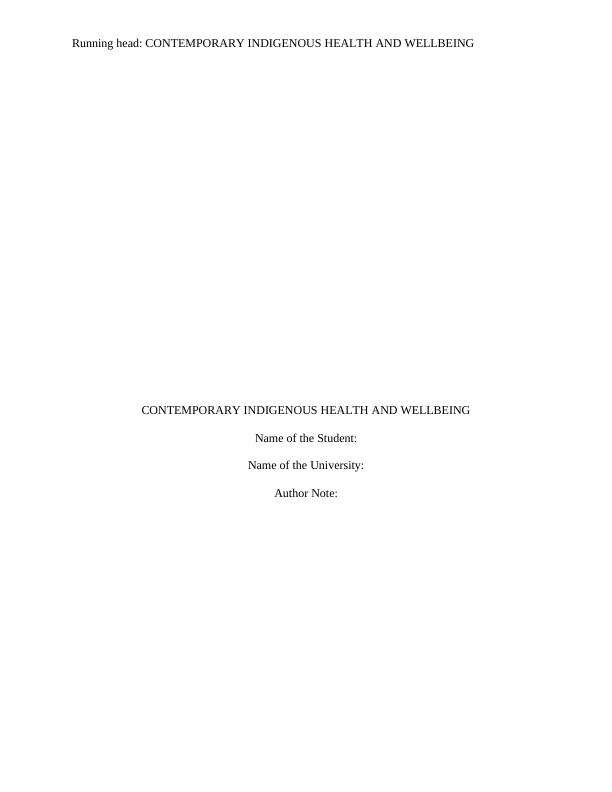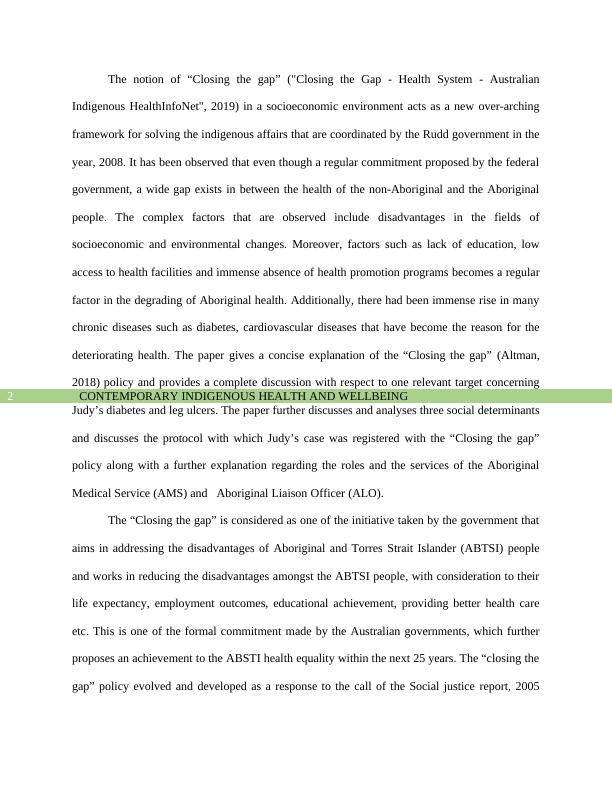Contemporary Indigenous Health and Wellbeing | Study
Added on 2022-09-07
8 Pages2267 Words15 Views
Running head: CONTEMPORARY INDIGENOUS HEALTH AND WELLBEING
CONTEMPORARY INDIGENOUS HEALTH AND WELLBEING
Name of the Student:
Name of the University:
Author Note:
CONTEMPORARY INDIGENOUS HEALTH AND WELLBEING
Name of the Student:
Name of the University:
Author Note:

CONTEMPORARY INDIGENOUS HEALTH AND WELLBEING2
The notion of “Closing the gap” ("Closing the Gap - Health System - Australian
Indigenous HealthInfoNet", 2019) in a socioeconomic environment acts as a new over-arching
framework for solving the indigenous affairs that are coordinated by the Rudd government in the
year, 2008. It has been observed that even though a regular commitment proposed by the federal
government, a wide gap exists in between the health of the non-Aboriginal and the Aboriginal
people. The complex factors that are observed include disadvantages in the fields of
socioeconomic and environmental changes. Moreover, factors such as lack of education, low
access to health facilities and immense absence of health promotion programs becomes a regular
factor in the degrading of Aboriginal health. Additionally, there had been immense rise in many
chronic diseases such as diabetes, cardiovascular diseases that have become the reason for the
deteriorating health. The paper gives a concise explanation of the “Closing the gap” (Altman,
2018) policy and provides a complete discussion with respect to one relevant target concerning
Judy’s diabetes and leg ulcers. The paper further discusses and analyses three social determinants
and discusses the protocol with which Judy’s case was registered with the “Closing the gap”
policy along with a further explanation regarding the roles and the services of the Aboriginal
Medical Service (AMS) and Aboriginal Liaison Officer (ALO).
The “Closing the gap” is considered as one of the initiative taken by the government that
aims in addressing the disadvantages of Aboriginal and Torres Strait Islander (ABTSI) people
and works in reducing the disadvantages amongst the ABTSI people, with consideration to their
life expectancy, employment outcomes, educational achievement, providing better health care
etc. This is one of the formal commitment made by the Australian governments, which further
proposes an achievement to the ABSTI health equality within the next 25 years. The “closing the
gap” policy evolved and developed as a response to the call of the Social justice report, 2005
The notion of “Closing the gap” ("Closing the Gap - Health System - Australian
Indigenous HealthInfoNet", 2019) in a socioeconomic environment acts as a new over-arching
framework for solving the indigenous affairs that are coordinated by the Rudd government in the
year, 2008. It has been observed that even though a regular commitment proposed by the federal
government, a wide gap exists in between the health of the non-Aboriginal and the Aboriginal
people. The complex factors that are observed include disadvantages in the fields of
socioeconomic and environmental changes. Moreover, factors such as lack of education, low
access to health facilities and immense absence of health promotion programs becomes a regular
factor in the degrading of Aboriginal health. Additionally, there had been immense rise in many
chronic diseases such as diabetes, cardiovascular diseases that have become the reason for the
deteriorating health. The paper gives a concise explanation of the “Closing the gap” (Altman,
2018) policy and provides a complete discussion with respect to one relevant target concerning
Judy’s diabetes and leg ulcers. The paper further discusses and analyses three social determinants
and discusses the protocol with which Judy’s case was registered with the “Closing the gap”
policy along with a further explanation regarding the roles and the services of the Aboriginal
Medical Service (AMS) and Aboriginal Liaison Officer (ALO).
The “Closing the gap” is considered as one of the initiative taken by the government that
aims in addressing the disadvantages of Aboriginal and Torres Strait Islander (ABTSI) people
and works in reducing the disadvantages amongst the ABTSI people, with consideration to their
life expectancy, employment outcomes, educational achievement, providing better health care
etc. This is one of the formal commitment made by the Australian governments, which further
proposes an achievement to the ABSTI health equality within the next 25 years. The “closing the
gap” policy evolved and developed as a response to the call of the Social justice report, 2005

CONTEMPORARY INDIGENOUS HEALTH AND WELLBEING3
along with the “Close the gap” social justice campaign. By March 2008 the ABSTI population
and the Australian governments had come together to work alongside and ultimately achieve the
equality in life expectancy and specifically in the health status. The policy further aimed to settle
an equilibrium in between the non-indigenous Australians and the ABTSI people by the year
2030 by signing the Indigenous Health equality summit statement of intent. Successively, in
order to monitor the changes the Council of the Australian Governments (COAG) had made a
protocol, which had a set of measurable targets that would help in checking the improvements
made in the departments of health and wellbeing of the ABTSI population.
The project targets include:
Closing the gap in case of the life expectancy of the people by the year 2013
Decrease the gap by half, in child mortality by the year 2018
Ensuring a 95 percent of the four years old children from ABTSI population to be
enrolled in early education by the year 2025
Closing the gap in case of attending the school by the year 2018.
Reduce the gap by halve in case of reading, writing and numeracy by the year
2018
Half the gap in the attainment of year 12 by the completion of 2020
Half the gap in the field of employment by the year 2018
The case of Judy explains that she is an old, 57 year old widow who is suffering from chronic
disease like diabetes and have a leg ulcer that needed dressings on a daily basis. Thereby, the
concerning target that can be focused in the policy are the prospect of closing the gap by
incrementing the rate of life expectancy of the indigenous people of the ABTSI population
(Browne, Hayes & Gleeson, 2014). The National partnership agreement on providing delivery of
along with the “Close the gap” social justice campaign. By March 2008 the ABSTI population
and the Australian governments had come together to work alongside and ultimately achieve the
equality in life expectancy and specifically in the health status. The policy further aimed to settle
an equilibrium in between the non-indigenous Australians and the ABTSI people by the year
2030 by signing the Indigenous Health equality summit statement of intent. Successively, in
order to monitor the changes the Council of the Australian Governments (COAG) had made a
protocol, which had a set of measurable targets that would help in checking the improvements
made in the departments of health and wellbeing of the ABTSI population.
The project targets include:
Closing the gap in case of the life expectancy of the people by the year 2013
Decrease the gap by half, in child mortality by the year 2018
Ensuring a 95 percent of the four years old children from ABTSI population to be
enrolled in early education by the year 2025
Closing the gap in case of attending the school by the year 2018.
Reduce the gap by halve in case of reading, writing and numeracy by the year
2018
Half the gap in the attainment of year 12 by the completion of 2020
Half the gap in the field of employment by the year 2018
The case of Judy explains that she is an old, 57 year old widow who is suffering from chronic
disease like diabetes and have a leg ulcer that needed dressings on a daily basis. Thereby, the
concerning target that can be focused in the policy are the prospect of closing the gap by
incrementing the rate of life expectancy of the indigenous people of the ABTSI population
(Browne, Hayes & Gleeson, 2014). The National partnership agreement on providing delivery of

End of preview
Want to access all the pages? Upload your documents or become a member.
Related Documents
Contemporary Indigenous Health And Wellbeing Report 2022lg...
|8
|2234
|15
Closing the Gap Policy and its Significance to Indigenous Australianslg...
|9
|2301
|364
Contemporary Indigenous Health and Wellbeing - DOClg...
|9
|2554
|138
Contemporary Indigenous Health and Well-being | Essaylg...
|8
|2220
|524
Contemporary Indigenous Health and Wellbeinglg...
|10
|2616
|445
Contemporary Indigenous Health and Wellbeing| Reportlg...
|9
|2535
|30